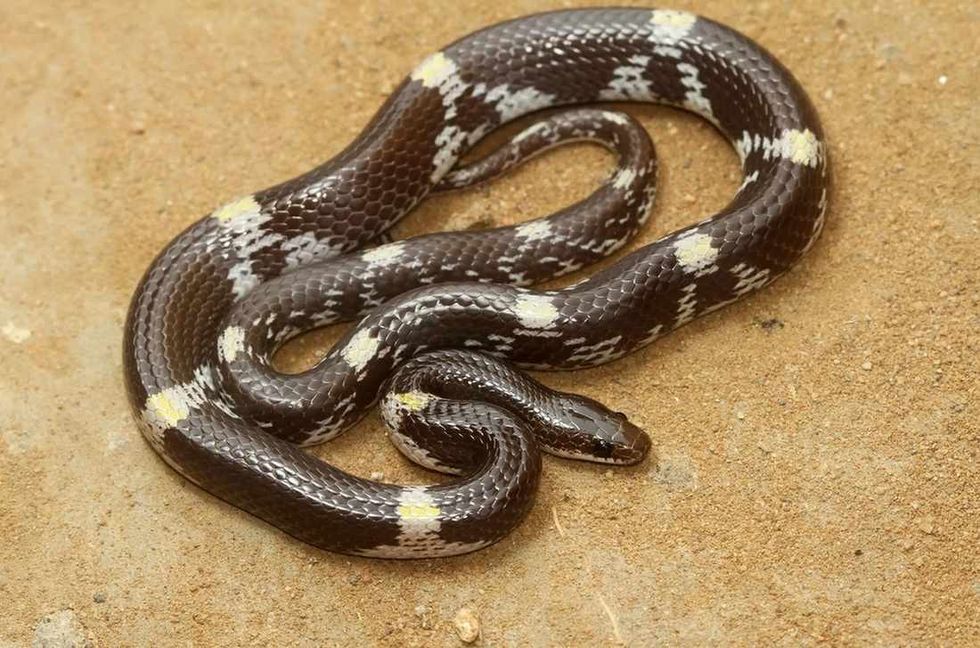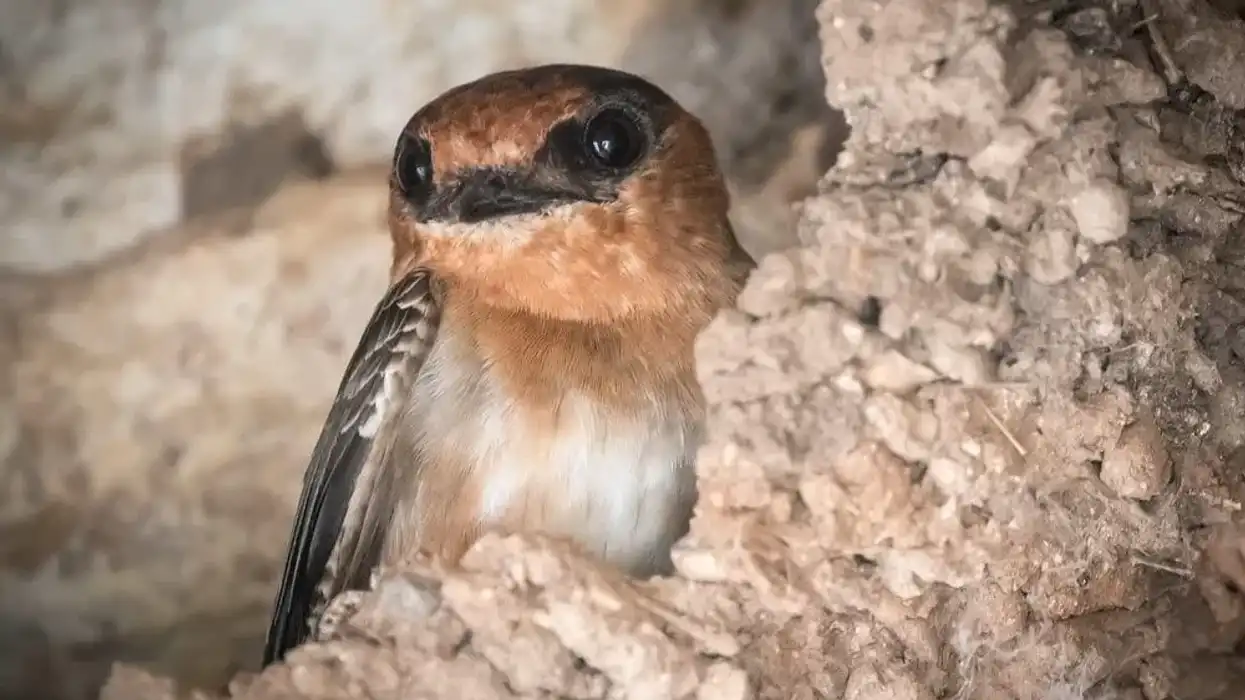One of the most infamous, limbless, deadliest reptiles to occur on earth are serpents. These scaly, limbless reptiles are worldwide and move around with undulating motion.
These reptiles are commonly known as snakes. Snakes can be viviparous or oviparous, they can also be venomous or non-venomous depending on a lot of factors.
This fact file is about such a serpent, native to the Indian subcontinent, a common wolf snake (Lycodon aulicus).
It is found across Southeast Asia in countries India, Ceylon, Burma, Siam, Malayan peninsula, Philippines. A common wolf snake (Lycodon aulicus) is a non-venomous snake belonging to the genus Lycodon, phylum Chordata, the genus of colubrid snakes.
This snake species is often mistaken for the Indian wolf snake (Lycodon capucinus). Their peculiar features are the presence of set teeth in both the jaws and aggressive nature the result of which is their instinct of biting the individual/organism they sense as a threat.
Here are some of the interesting facts about the common wolf snake (Lycodon aulicus) that will surely intrigue you. Afterward, do read our other articles on plain-bellied water snake and Texas indigo snake as well.
Wolf Snake Interesting Facts
What type of animal is a wolf snake?
The common wolf snake (Lycodon aulicus) is a snake, a serpent of the genus Lycodon. These limbless snake reptiles are swift and show undulating motion. The exoskeleton of the Indian wolf snake (Lycodon capucinus) changes color and is a mechanism for camouflage. These serpents are non-venomous and have enlarged front teeth which have a resemblance to canines.
What class of animal does a wolf snake belong to?
Common wolf snake (Lycodon aulicus), belongs to the class reptilia of phylum Chordata in kingdom Animalia. More specifically Indian wolf snake (Lycodon capucinus) belongs to the family colubridae of order Squamata.
There are a variety of wolf snakes such as Indian wolf snakes, common wolf snakes, who use their venom to subdue their prey while hiding in rocks or open ground.
How many wolf snakes are there in the world?
There is no proper count of Indian wolf snake (Lycodon capucinus) but this snake species are found in abundance in India, Malaysia, and throughout Southeast Asia. Around 20 species of Lycodon are found across their range of habitats including the Indian wolf snake (Lycodon capucinus) and common wolf snake (Lycodon aulicus).
These snakes are known to be most active during the night around rocks and low vegetation ground.
Where does a wolf snake live?
Common wolf snake (Lycodon aulicus) is seen nesting in aquatic habitats across South Asia where their prey is present in abundance. They are found in India (in Himalayas and Assam more specifically), Myanmar, Pakistan, China (in Fujian, Guangdong, Yunan, and Hong Kong), in Mauritius.
In the Philippines, this snake species is found only in a few Islands residing along rocks and low vegetation ground.
What is a wolf snake's habitat?
Wolf snakes are found nestling in grasslands, in ant mounds, and burrows near water bodies such as a stream, a lake, or a river body for feeding and breeding. These snakes are most active during the night.
Who do wolf snakes live with?
These nocturnal beings dwell in dark crevices of figs and other trees solitarily and are mostly spotted by themselves during the night. A wolf snake-like any other snake; it is always alert and aggressive when it comes to defending itself.
This snake species aggressively bite humans if they sense any threats. Hence this snake species is never found coexisting with other animals.
How long does a wolf snake live?
The average lifespan of this water snake species native to India is around ten years. Some may even live longer in captivity. A wolf snake is mostly a water snake hence its average life span is around nine to ten years as well.
How do they reproduce?
New world wolf snakes are viviparous in nature while old world wolf snakes are oviparous in nature. They breed around monsoon season and lay around 4-11 eggs. The hatchlings hatch out of eggs in September or October and are around 6 in (15 cm) in length.
What is their conservation status?
There is no update on the conservation status of wolf snakes but these nocturnal reptiles are found in a good number in their habitat. But the threat is imposed on their survival with frequent loss of their natural habitat due to urbanization and human settlements.
Wolf Snake Fun Facts
What do wolf snakes look like?
Often mistaken for a common krait, a wolf snake has uniform dark brown and black scales throughout which assist them in camouflaging while catching prey. They have a distinct broad snout, flattened head, a forked tongue, and a swollen upper lip.
Their entire body is slender and white patches are there on the abdomen. Both their jaws have a set of sharp teeth and the upper jaw has a pair of two large teeth.
These snakes are nervous creatures and bite almost immediately when they are picked up. They have dark pupils which are almost invisible when seen.
How cute are they?
Snakes can never be cute with a flattened head and larger body, and a duck-bill snout. They are dangerous irrespective of them being venomous or non-venomous.
Lycodon aulicus have very sharp teeth and they bite very aggressively. The place where they bite a human being remains swollen and painful for several days. It is better to avoid their company in the vicinity or in their natural habitat.
How do they communicate?
Snakes in general are not very vocal but they have their unique way of communicating. Snakes communicate through pheromones, these are chemical hormones that assist these snakes in communicating with others of their species and also recognizing possible threats such as humans and other predators.
Besides, they also produce a hissing sound and open their jaws to scare off the threats.
How big is a wolf snake?
A wolf snake is a medium-sized slender serpent whose size range is 20 in (50.8 cm) in length. These snakes are almost the same size as common kraits.
How fast can a wolf snake move?
A wolf snake is amongst the fastest snakes found on earth. They dwell on the land, move on the tree with swift undulating motion and swim very swiftly in water. They move with an average speed of 3.5 mph (5.6 kph).
How much does a wolf snake weigh?
The average weight range of these snakes is 55-88 lb (24.9-39.9 kg).
What are the male and female names of the species?
A wolf snake does not really have separate male and female names. They are simply recognized by their few distinct physical features but are not referred to with separate names.
What would you call a baby wolf snake?
A wolf snake hatchling is referred to as a snakelet or a neonate. These snakelets measure around 5-7 in (12-17 cm) in length on average and are born with rows of teeth. The juvenile wolf snakes do not have big front teeth or fangs from birth but grow them when they reach maturity.
What do they eat?
Wolf snakes are carnivores and commonly prey on small mammals and reptiles. They camouflage themselves upon the bark of the trees or on the ground amongst leaves and twigs and feed on geckos, skinks, frogs, lizards, and rodents dwelling in their habitats.
Are they poisonous?
Wolf snakes are not venomous but are good biters. They are usually harmless but can bite when they are handled aggressively. Humans are not really harmed when they bite them but the bites are painful and linger around for a long time. The affected area if not treated properly can be septic.
Would they make a good pet?
These snakes can be kept in captivity for various purposes such as research but they are not to be taken as pets. It is an uncommon and illegal practice to take these snakes as pets but quite a few people keep them in their households as their pets.
Their diet comprises geckos, frogs, lizards, and skinks and other small mammals.
Did you know...
Wolf snakes, just like other serpents have a presence of a sensory organ viz., Jacobson's organ. This organ is connected to the floor of the snake's mouth, which assists them in picking up the odors from their surroundings.
A Jacobson's gland is an olfactory organ and has a blind sac that has a duct opening anteriorly. This is rich in blood vessels and glandular networks.
What smells do snakes hate?
Snakes in general do not like the smell of ammonia and hence ammonia compounds are used in snake various repellants. The presence of Jacobson’s gland, a sensory organ, makes them very sensitive to strong odors such as the odor of cinnamon and clove oil.
Apparently in India, using substances with these odors is a very common practice hence it is a good way to keep these snakes away from their vicinity.
What eats a snake in a food chain?
To keep balance in the food chain the snakes also have predators such as mongooses, foxes, raccoons, coyotes, and large bird species that feed on them. In this way, they do not exceed in numbers in their habitats.
Here at Kidadl, we have carefully created lots of interesting family-friendly animal facts for everyone to discover! For more relatable content, check out these regal horned lizard facts and striped whipsnake facts pages
You can even occupy yourself at home by coloring in one of our Wolf Snake coloring pages.










